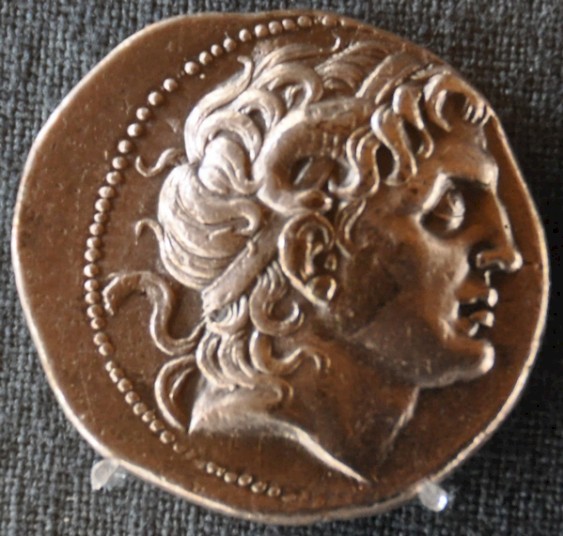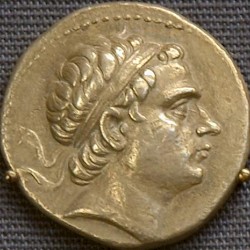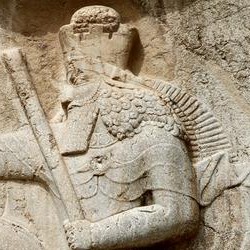Diadem
Diadem: an often decorated ribbon tied around the head, used as a symbol of royal dignity.
Origins

As symbol of royal dignity, the diadem has two origins. In the first place, there is the ancient Near East - more specifically, the Achaemenid Empire - where the use of turbans was subject to very specific rules. For example, only the king was allowed to tie his turban ("tiara") in such a fashion that it stood erect, as one can see on the famous portrait of king Darius III Codomannus on the Alexander Mosaic. Other important men, like the princes of the Persian royal house and the representatives of subject nations (like the Elamites depicted on the eastern stairs of the Apadana in Persepolis), wore special turbans too, which they often tied with a ribbon in a way that is not unlike the manner in which a modern Arab ties his shemagh. In Antiquity, the decoration of the ribbon could indicate someone's status.

A second origin is the traditional wreath or garland, which was used in the Greek religion. Wreaths are already known from Mycenaean times, where sets of golden plates often covered the forehead of the illustrious people buried in the tombs ("funerary diadems").
In the classical age, several Greek gods that were connected with death and the afterlife are shown with diadem-like objects: Heracles, Hades, and Dionysus, for example. Diodorus of Sicily says that Dionysus invented the object to assuage the headaches that he was suffering from - after all, he was the god of the wine.note Later, other gods were depicted with garlands too, like Zeus (on Phidias' statue in Olympia), and Apollo, who was said to have accepted the laurel wreath as a memory of a girl he loved, Daphne.
The first diadems

If we ignore the statue by Polyclitus, made in ca.420 BCE, of a young athlete tying his hair (called the Diadumenos by the art historian J.J. Winckelmann but in fact not showing a diadem but a practical gesture without deeper significance), the wreath became a symbol in the early fourth century. Then, several rulers in the Greek world started to tie golden wreaths around their head, especially during religious ceremonies. For example, the tyrants of Syracuse, Dionysius I and Dionysius II, are known to have been wearing these objects and Persian vestments.
The exact significance of these diadems is not known, but the objects suggest that the rulers claimed some sort of superhuman status and demanded the respect that was also shown to the gods. This is more or less confirmed by the Persian vestments, because by then, many Greeks believed (erroneously) that the Persian king was considered by his subjects to be divine.
Macedonian Diadems
Similar objects are known from the royal tombs at Vergina (ancient Aegae), where the Macedonian kings were buried. We know that by the end of his life, the Macedonian king Philip II was venerated as Zeus Philippios at Eresus (a town on the island Lesbos), that Philip's statue was placed next to that of Artemis in the famous sanctuary at Ephesus, and that he received similar honors in the shrine of Heracles at Athens. The Macedonian ruler was raised to a state higher than ordinary men and he was probably even called equal of the gods (isotheos).

By now, there was hardly any difference between the Greek wreath, which had become a symbol of semi-divine monarchy, and the oriental diadem, which the Greeks believed to be the symbol of divine monarchy. It comes as no surprise that Alexander the Great, after he had defeated his opponent Darius III Codomannus (330), started to wear a diadem. Several years later, Alexander granted his friends Hephaestion, Leonnatus, Nearchus, Peucestas, and Ptolemy the right to wear a diadem too. This was in accordance with the eastern practice, which allowed important people to tie their hair with a diadem; in the west, it had implied divinity. It seems that Alexander, who was, after all, the son of Ammon, had horns attached to his diadem, something shown on his coins and mentioned by Ephippus.
Hellenistic Diadems

From now on, the diadem, the ends of which fell upon the shoulders, was an accepted symbol of royal power. There is a bust of Alexander's brother and successor Philip Arridaeus with a diadem, and we know that about ten years after his death, the Diadochi ("successors" of Alexander) accepted the diadem too (306; text): first Antigonus Monophthalmus and his son Demetrius I Poliorcetes, but also Lysimachus of Thrace and Ptolemy of Egypt.
Other rulers copied this symbol, but not everyone. We know that Cassander of Macedonia and the kings of Sparta did not wear it, and on Sicily, where the custom had been invented, king Agathocles of Syracuse refused the diadem as well. Nevertheless, the object was now common - at least among monarchs in East and West - and we can see diadems on the coins of the Seleucid and Parthian kings.
Their successors, the Sasanian kings, are also shown with diadems, which were now longer than before and fell almost to the waist. This is visible on many "investiture scenes" on the Sasanian rock reliefs, where the supreme god Ahuramazda hands over the ring of power (cydaris) to the diademed king.
 Herculaneum, Villa of the Papyri, Ptolemy III Euergetes |
 Coin of Antiochus III the Great |
 Phraates II |
 Naqš-e Rustam, Investiture relief of Ardašir I, Ahuramazda |
The Ptolemaic rulers, adopting a pharaonic custom, had an asp upon their diadems. From Ptolemy IV Philopator (222-204) onward, the Egyptian diadem was also decorated with sun rays, which may be derived from the ancient belief that the pharaoh was protected by the sun god Ra. It may have been a concession to the native population, which became increasingly important during the reign of this king.

The diadem as symbol of royal power was also known in Judaea, where Messianic claimants like Simon of Peraea and Athronges the Shepherd (both immediately after the death of king Herod the Great) are known to have accepted diadems. The crown of thorns that the soldiers of Pontius Pilate gave to Jesus of Nazareth must have been a cruel parody of this royal symbol, but it should be noted that the gospels use the word stephanos, "wreath".note This suggests that the ancient connection between wreaths and death was not yet forgotten. At the same time, however, the wreath was a symbol of victory. The writer of the Gospel may have recognized the irony that Jesus' disgraceful death was presented with triumphal ornaments.
Roman Wreaths and Crowns
In Rome, the political symbol was not accepted. The Republic had very bad memories about the monarchy of king Tarquinius Superbus. Admittedly, there is one Roman magistrate known as Lucius Caecilius Metellus Diadematus (consul 117 BCE), but he got this surname because of a head wound. When Julius Caesar wanted to adopt the diadem as symbol of his one-man rule (44 BCE), the Roman populace was very angry, and he ordered the object to be dedicated to Jupiter, and instead accepted the laurel wreath (text). When Mark Antony assumed the diadem after his marriage to the Ptolemaic queen Cleopatra VII of Egypt, this caused just as much indignation.

As we could have expeced, diadems were almost never used during the early Roman Empire. An emperor always presented himself as a common senator, and only on religious festivals would he wear a laurel wreath. (Several emperors are shown with wreaths on their coins.) The surname Diadumenianus was given to the son of the Roman knight (and future emperor) Macrinus in 208 CE, but this was because he was born with a caul, and it is just coincidence that Macrinus and the boy were briefly to be emperor in 217-218.
It is only in the fourth century that diadems with diamonds and pearls became symbols of imperial power. They are shown on several gold pieces from that age.
Late Antiquity

In Late Antiquity, the Langobards used an iron diadem, in fact a kind of small hoop, which the German emperors of the Middle Ages would decorate with gold plates and precious gems. The crowns of modern monarchs are derived from this model.
The pointed crown that children often draw is ultimately derived from the Ptolemaic diadem with sun rays. They are shown on Roman coins from the mid-third century CE, and disappear when the pearly diadem becomes popular. Why the pointed crown has survived in popular imagination, is a mystery.